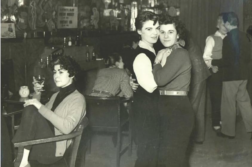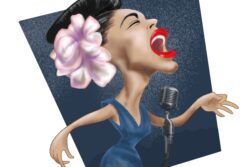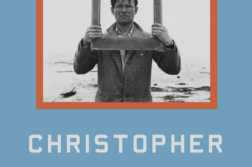 A Queer History of the United States
A Queer History of the United States
by Michael Bronski
Beacon. 288 pages, $27.95
THIS BOOK is the first in a Beacon Press series, “ReVisioning American History,” that’s dedicated to exploring our nation’s past from the perspective of those “who have been excluded from the canon.” Bronski’s scope is ambitious: he stretches the definition of “American” to include everything from Columbus’ arrival in 1492 to the arrival of AIDS in the 1980’s. In his introduction, he lays out his caveats: this history is not comprehensive; it cannot pretend to be objective; it is not linear; and it is as much about how GLBT people have shaped U.S. history as it is about how they were shaped by it.
In surveying the culture of North America in the period leading up to the American Revolution, Bronski identifies the main themes that will play out in later eras. He frames this discussion in terms of how “persecution” was used as a stabilizing force to address the tension between individuals’ private practices and the demands of society. Key to this process was the opposition between “purity” and “danger.” Bronski outlines how early Native American cultures, with their relatively fluid gender roles and sexual permissiveness, were seen as a threat to the Puritan culture in which family was paramount, sex was for procreation, and gender roles were rigidly defined.
Of course, Bronski is not the first historian to examine the cultural landscape of 16th-century North America. He makes good use of the work done by earlier historians, notably Jonathan Ned Katz and Mary Douglas, and he takes a measured view of pre-Revolutionary America, willing to confront widespread assumptions (such as stereotypes of American Puritans). He balances his use of historical work with ample selections from primary source material, including journals, letters, and the like.
In examining the events leading up to and through the American Revolution, Bronski focuses upon the tension between the private and public spheres, and he begins to outline the formation of American ideas about gender identity. In a chapter called “Imagining a Queer America” and in the next two chapters, Bronski’s ideas about masculinity, femininity, and same-sex desire in early America began to coalesce in life, literature, and politics in the U.S. at that time. This was when American literature came into its own, and Bronski provides a good overview of the same-sex themes in the work of Emerson, Thoreau, Hawthorne, Melville, Margaret Fuller, Emily Dickinson, and, of course, Walt Whitman.
One cannot attempt to tell the story without confronting the realities of slavery and racism, and Bronski skillfully weaves these considerations into his narrative. He does not shy away from calling out well-known feminist and gay figures who had racist beliefs, such as M. Carey Thomas, a 19th-century advocate for women’s education who believed in white supremacy, and Margaret Sanger, an early champion of birth control who held racist and eugenicist views. He also explores the debt that GLBT causes owe to the American labor movement of the late 19th and early 20th centuries. In exploring these intertwining influences so thoroughly and honestly, Bronski holds true to his conviction that gay history, like any history of any people or subculture, has no clear boundaries. He also tries to shed light on the more obscure parts of the story. In later chapters that examine the growing urbanization of America and the rise of cultural centers like New York, Hollywood, and San Francisco, he cites the stories of lesser-known pioneers as well as more famous names.
One of the unifying ideas of Bronski’s history is that war is a potent force for cultural change. He shows how this applies to the Civil War as well as to World War II, which played a central role in shaping modern gay and lesbian culture. Indeed he sees the influence of the latter war upon American popular culture—on fiction, film, theater, television, and music— as so vast that he courts overstatement, not to mention sheer tedium, as he offers up long lists of book titles and plot summaries from the 1940’s. But this thoroughness does illustrate the sheer breadth of gay and lesbian contributions to America’s post-war cultural transformation.
It’s when Bronski turns to more recent GLBT history—the unrest of the 60’s and 70’s, the impact of AIDS in the 80’s and beyond—that the limitations of his scope are most apparent. His earlier caveats about comprehensiveness aside, it’s difficult to accept such a brief discussion of the Stonewall riots, for example, or to see Harvey Milk’s contributions described in just a few sentences. Ending his history in the late 80’s, he uses an epilogue to discuss GLBT history since the 90’s. Here he appears more comfortable asserting his own viewpoint, particularly with respect to the debate over gay marriage. And he reminds us that this draft of history is merely one contribution to an ongoing discussion. It’s a contribution that will undoubtedly prove valuable, perhaps even foundational, to future students of gay American history.
________________________________________________________
Jim Nawrocki, a freelance writer based in San Francisco, is a frequent contributor to these pages.






